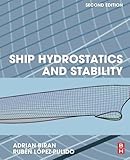Ship hydrostatics and stability / Adrian Biran, Rubén López-Pulido ; with contributions by Javier de Juana Gamo.
Publisher: Amsterdam : Elsevier : Butterworth-Heinemann, c2014Edition: Second editionDescription: xxii, 392 pages : illustrations ; 24 cmISBN:- 9780080982878 (pbk.)
- 623.81 23 BIR
| Item type | Current library | Call number | Copy number | Status | Date due | Barcode |
|---|---|---|---|---|---|---|
 Book Open Access
Book Open Access
|
Engineering Library | 623.81 BIR 1 (Browse shelf(Opens below)) | 1 | In transit from Engineering Library to Maritime Institute Library since 12/14/2023 | MTIL23060015 | |
 Book Open Access
Book Open Access
|
Engineering Library | 623.81 BIR (Browse shelf(Opens below)) | 2 | In transit from Engineering Library to Maritime Institute Library since 12/14/2023 | MTIL23070123 | |
 Book Open Access
Book Open Access
|
Engineering Library | 623.81 BIR 3 (Browse shelf(Opens below)) | 3 | In transit from Engineering Library to Maritime Institute Library since 12/14/2023 | MTIL23080558 |
Chapter 1. Definitions, Principal Dimensions
1.1 Introduction
1.2 Marine Terminology
1.3 The Principal Dimensions of a Ship
1.4 The Definition of the Hull Surface
1.5 Coefficients of Form
Chapter 2. Basic Ship Hydrostatics
2.1 Introduction
2.2 Archimedes’ Principle
2.3 The Conditions of Equilibrium of a Floating Body
2.4 A Definition of Stability
2.5 Initial Stability
Etc.
Chapter 3. Numerical Integration in Naval Architecture
3.1 Introduction
3.2 The Trapezoidal Rule
3.3 Simpson’s Rule
3.4 Calculating Points on the Integral Curve
3.5 Intermediate Ordinates
Etc.
Chapter 4. Hydrostatic Curves
4.1 Introduction
4.2 The Calculation of Hydrostatic Data
4.3 Hydrostatic Curves
4.4 Bonjean Curves and their Use
4.5 Some Properties of Hydrostatic Curves
Etc.
Chapter 5. Statical Stability at Large Angles of Heel
5.1 Introduction
5.2 The Righting Arm
5.3 The Curve of Statical Stability
5.4 The Influence of Trim and Waves
Chapter 6. Simple Models of Stability
6.1 Introduction
6.2 Angles of Statical Equilibrium
6.3 The Wind Heeling Arm
6.4 Heeling Arm in Turning
6.5 Other Heeling Arms
Etc.
Chapter 7. Weight and Trim Calculations
7.1 Introduction
7.2 Weight Calculations
7.3 Trim
7.4 The Inclining Experiment
Chapter 8. Intact Stability Regulations I
8.1 Introduction
8.2 The IMO Code of Intact Stability
8.3 The Regulations of the US Navy
8.4 The Regulations of the UK Navy
8.5 A Criterion for Sail Vessels
Etc.
Chapter 9. Stability in Waves
9.1 Introduction
9.2 The Influence of Waves on Ship Stability
9.3 The Influence of New Ship Forms
9.4 The Mathieu Effect—Parametric Resonance
9.5 Pure Loss of Stability
9.6 The Activities of IMO and of Professional Societies
Chapter 10. Intact Stability Regulations II
10.1 Introduction
10.2 The Regulations of the German Navy
Chapter 11. Flooding and Damage Condition
11.1 Introduction
11.2 A Few Definitions
11.3 Two Methods for Finding the Ship Condition After Flooding
11.4 Damage Conditions Assessment
11.5 Details of the Flooding Process
Etc.
Chapter 12. Linear Ship Response in Waves
12.1 Introduction
12.2 Linear Wave Theory
12.3 Modelling Real Seas
12.4 Wave Induced Forces and Motions
12.5 Uncoupled Motions
Etc.
Chapter 13. Computer Methods
13.1 Introduction
13.2 Geometric Introduction
13.3 Hull Modelling
13.4 Modelling with FORAN
13.5 Recent Developments
Etc.
References
Includes bibliographical references pages 369-379 and index. p 389-392


There are no comments on this title.